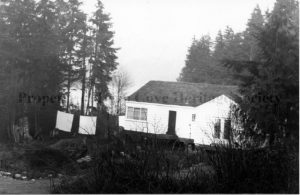
(Above is a photo of my grandmother’s family home)
As a young listener, the stories I was told seemed to be intentionally planted into my mind to tell me a narrative of national and familial pride. I was bred to believe that our Nation was a dystopian reality, and my family home was “ours”. I believed this narrative, but I always felt like something was missing. My questions began in public school, where “Social Studies” class was imposed Canadian identity and history upon our young and impressionable minds. I enjoyed it because I felt partly a part of it. What I mean by “partly a part of it” is that my white-settler colonial ancestry was represented. The other part of me, my Canadian Carribean identity, felt forgotten or unimportant. This contradicting sense of both belonging and exclusion has prompted my disillusion with the highly promoted “Canadian identity”.
The canon of Canadian literature imposes upon us a story of settler colonialism, which commonly describes the land as barren and resources abundant. Stories like these allow for the “forgetting” or “unlearning” of a harmful colonial reality. Chamberlin describes how the settlers arriving in Canada in the Nations’ early years were displaced people seeking a place of hope and refuge, but the land itself was not vacant therefor further displacement took place. The stories that have enabled an “imagine” past, neglect to inform us of a counter “reality”. What isn’t told in the hegemonic narrative is the histories and realities of the indigenous populations and the cultural genocide which took place.
This duality between the imagined and the real has prompted Chamberlin’s dialogue on questions of what is true, and what is false, especially in the context of stories of “Home”. Stories of settler colonialism intentionally suppress the voices of indigenous and displaced populations. This was done through the stripping of their inherent agency over their land, their languages, their ceremonies, and their history. The loss of these incredibly important and functional and cultural factors are still being unveiled, as the individuals and the descendants who faced forced cultural deterioration work to retell their stories. With growing access to contrasting histories, the dialogue of what is true or imagined grows, and questions regarding Canadian Nationhood arise.
In this course, we look at the contradiction of a very prominent line in the Canadian National Anthem: “Oh Canada, Our Home, and Native land.” This line tells us a story, but as we learn more about the difference between “Home” and “land”, this national statement begs us to ask further questions. What is our home? What is the native land? Is one real? Is one imagined? Can they exist simultaneously? In my own experience upon this land which I call home, I call forth these questions.
Through stories of home, both imposed by the nation and through stories passed down through our family history upon this land, I’ve experienced a very conflated understanding of self. I live along the Burrard Inlet, in a community which I’ve known to call Deep Cove. My Great grandparents were Pioneers on this land, and to show for it we have a brick and a bench with our name on it, with our stories embedded in the pages of the archives in the heritage center. As a teenager into young adulthood, I prided myself on the fact that my family had lived upon that land since the 1940s.
Growing up, I wasn’t told of who was there before us. I didn’t know about the sacrifices that were made and who had to make them so I could boast my entitlement to the land. Entering my first semester at Capilano University, I learned about residential schools and Truth and Reconciliation. I listened to Ta’ah Amy George, a Tsleil-Waututh elder, speak about her experiences in residential schools and its residual effects. I remember feeling deep guilt and anger, but I also felt injustice. This injustice was not only regarding the abuse, violence, and genocide that contributed to the forming of Canada but also the injustice of the knowledge and stories that were kept from me.
Why was I conditioned to believe the unfair and racist stereotypes imposed upon indigenous populations, when the stories we were told of our pasts were incomplete, tilting in favor of settler population. How could I trust a nation that had tried to drown out the cultures and livelihoods of multiple populations because of racial hierarchy? I felt tricked, as my national and familial pride deflated. My sense of “home” and “identity” was imagined, and now it was my job to re-learn the land, through the stories of the people that came before “us”. So I’m here to listen to the voices that deserve to be heard, through literature and ceremonial elements of the “story”.
Bellow, I have attached a link to a podcast by UBC’s own unceded airwaves, an indigenous lead radio show associated with CITR. This episode talks about the decolonization of the institution and what that might mean or look like.
I’ve also included a link to stories of the Tsleil-Waututh people told by Cheif Dan George, Annie (Ta’h) George and other Tsleil-Waututh storytellers. These stories speak of the Burrard Inlet, its characteristics and its formation. I recommend you read the Legend of Scnoki, which offers us a story of the two-headed snake and the shaping of the Inlet.
NATIVE LEGENDS OF THE INDIAN ARM AREA – Compiled and edited by Ralph Drew, Belcarra, B.C.
Link:
http://www.belcarra.ca/reports/Native_Legends_Of_The_Indian_Arm_Area.pdf
Thanks for Listening!
Yours best,
Lexi
References Cited
Unceded Airwaves. “Decolonizing UBC Campus”. Unceded Airwaves, CITR, 05 December, 2018. CITR. https://playlist.citr.ca/podcasting/audio/2018/Unceded-Airwaves-38687-154419-December-05-14-00-50.mp3
George, L et al. (2019). Native Legends of the Indian Arm Area. [online] Belcarra.ca. Available at: http://www.belcarra.ca/reports/Native_Legends_Of_The_Indian_Arm_Area.pdf [Accessed 16 Jan. 2019].